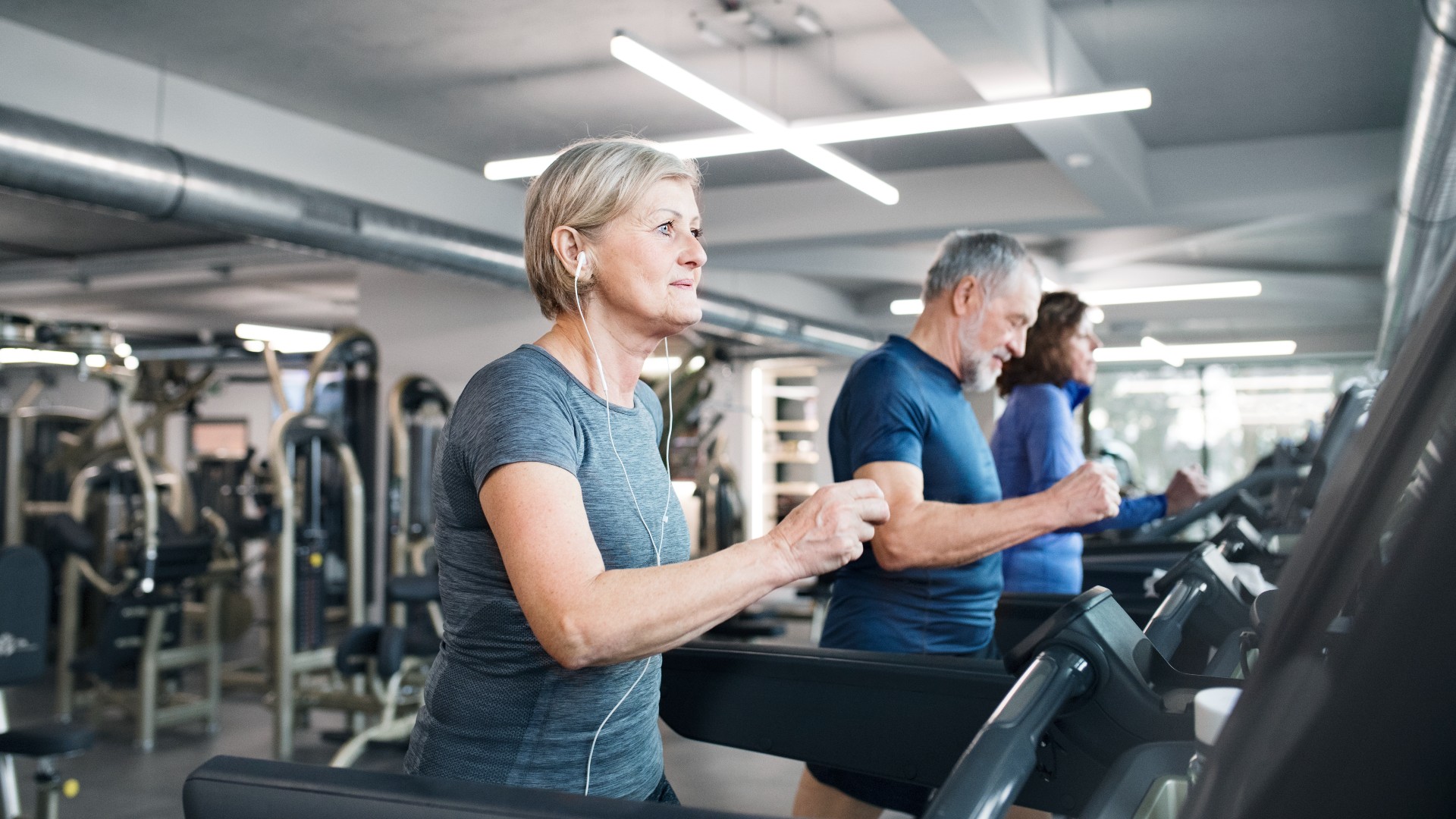Treadmill benefits: Six reasons to jump on the running machine today
Treadmill benefits: Six ways this aerobic workout can boost health

Treadmill benefits are both physical and mental — as well as providing a cardio workout that strengthens the body’s circulatory system and builds muscle, exercising on one of the best treadmills is a form of aerobic exercise that can also lift the mood and improve brain function. Treadmill training could even help blast stubborn belly fat, according to a Medicine & Science in Sports & Exercise study.
As with any cardio workout that gets your heart rate up, treadmills are great for increasing cardiovascular fitness, which reduce the risk of coronary and chronic diseases. The great thing about treadmills is they offer an indoor workout where you can walk, jog or run with speeds and gradients to make your training more challenging.
“There are many benefits to adding treadmill training into your exercise routine and the convenience of the machine makes it a useful tool in commercial and home gyms,” says registered physiotherapist Sam Preston. “It’s important to vary the style of your training, as there are different adaptations and responses to each stimulus you apply to the body.”
“Important principles to remember are consistency and progressive overload (gradually making training more challenging) if you want to maximize physical change. More importantly however, something is better than nothing and everybody's mind and body benefits from regular exercise that they enjoy. If you’re just beginning your exercise journey, or you’re recovering from illness or injury, be sure to consult your doctor before getting started.”
In this article we talk to Preston more about the many treadmill benefits.

Sam Preston is a physiotherapist with qualifications in Sport Rehabilitation. His entire career has revolved around helping people live a longer, happier and healthier life. His healthcare journey started by leading a team of therapists in England, treating ranges of ages and abilities, from office workers to professional athletes. He currently owns and operates a wellness retreat in Spain (Palm Rock Retreats) helping people recover, reset and rejuvenate.
Improves heart health
The heart needs exercise just like any other muscle in the body, and muscles that are used regularly and challenged get stronger and healthier.
Preston says: “As we know, regular cardiovascular exercise is essential for a healthy heart and we must treat it as the muscle that it is. Regular stress will bring positive adaptations. That means when a progressive program is applied, our heart becomes strong, healthy and happy.”
Get the world’s most fascinating discoveries delivered straight to your inbox.
A strong heart can pump blood more efficiently around the body, which can help reduce blood pressure, and it means it’s under less strain and able to work properly. A study published in Frontiers of Cardiovascular Medicine found that aerobic exercise could even reduce the risk of heart and chronic diseases.
Burns more calories
Out of all the cardio machines, running on a treadmill burns the most calories, a small study published in the Journal of the American Medical Association found.
Participants doing a ‘somewhat hard’ workout on the treadmill burned about 40 percent more kcals an hour (705) than on the least calorie intensive machine, the stationary bike (498). But Martin Hoffman, co-author of the study, noted that “all the machines were found to be good for maintaining or improving fitness.”
You can burn more calories on the treadmill by adding intensity to your workout — either by setting the treadmill to incline to run uphill, or increasing your speed. “Inclining the treadmill will not only increase the difficulty but also change your gait (walking/running) pattern slightly,” says Preston.
“If you suffer from some lower back discomfort when standing or walking for long durations, try this. If you just want a killer workout to your quads and glutes, turn that incline up.”
“You can manipulate how many calories you burn on any machine depending on how hard you work,” adds Preston. “However, where a treadmill can be useful is with LISS (low intensity steady state) exercise. Spending 30-45 minutes walking at a medium to high pace three to four times a week, alongside a controlled nutrition and resistance training program, will increase your calorie expenditure. This will help with losing fat and maintaining muscular strength and ‘tone’.”
Why medium to high pace? A study published in the Journal of Obesity found that when maintaining a 135bpm heart rate for long periods of time, our body has been shown to utilize energy from our fat stores more efficiently.

Muscle building
Does running build muscle? A study by experts from the Department of Kinesiology at Taylor University found that this type of 'aerobic exercise is an effective mode of activity for the promotion of cardiorespiratory fitness (capacity of the circulatory and respiratory system) and increase in the whole muscle size of the quadriceps (front of the thighs).
- Related: What muscles are used for running?
Walking — particularly on an incline — on one of the best walking treadmills can be also be an effective exercise tool: it increases the heart rate more than on the flat, so metabolically this means you burn more calories and body fat.
But Preston says: “As with all changes in muscle mass and body composition, nutrition is the fundamental behind making a big difference to one’s physique. That being said, a workout strategy that would be conducive to muscle building would be anaerobic capacity training: try adding some short 3-10 second, max effort interval sprints to your regular program.”
Improves brain function
Research in Scientific Reports found that a short 10 minute run is enough to improve the brain’s executive function — a complex set of processes that include memory, attention, planning, organization and impulse control.
Running was also linked to increased blood flow in the prefrontal cortex (PFC) — the part of the brain that plays an important role in cognitive control functions.
“A fundamental truth around exercise and a principle that everyone should prioritize is the positive brain chemistry responses to physical activity,” Preston told Live Science. “It improves the function of neurotransmitters such as dopamine and serotonin, which all have a role in improving concentration, motivation and happiness.
“And it only takes 10 minutes of hard exercise to reap the rewards. So if you’re feeling tired, lethargic or apathetic, perform some medium to hard running intervals and hack your brain chemistry for the better.”

Boosts sleep quality
Always tired? Cardio exercise like walking or running on treadmills triggers the release of melatonin, the sleep hormone that helps you get a better night’s rest.
A small study of chronic insomniacs published in the Journal of Clinical Sleep Medicine found that after four months, adding 30 minutes of cardio three times a week increases their sleep time by 45 minutes a night.
“We are continually learning more about sleep and how important it is for brain and body function, recovery and adaptation,” says Preston. “Research in the American Journal of Exercise has suggested that daily exercise can promote duration and quality of our sleep. Limiting caffeine later in the day, early sunlight exposure and a consistent sleep schedule can also positively affect your sleep.”
Lifts mood
Exercising on a treadmill is a great mental health boost as it increases the brain’s production of its feel-good neurotransmitters, endorphins, says Preston.
And while it’s often referred to as a ‘runner’s high’, all aerobic activity that gets the heart rate up will create the same mood-lifting effect.
“There are several other ways to boost your mood, regular sunlight exposure, fresh air and mindful meditation have all shown to elevate positive emotions. If you can find a nice balance of all of these habits, you will find it much easier to tackle a negative headspace.”
- Related: Best sports bras for running

Maddy Biddulph is a freelance health and fitness journalist with over 26 years of experience working for consumer media in the US and UK. As a Level 3 personal trainer and weight loss advisor she is used to trying out and reviewing the latest health and fitness products. At Maddy Biddulph Personal Training, she runs one-to-one and small group sessions, as well as group exercise classes. She specializes in mobility work with seniors and runs regular chair workouts in her hometown of Oxford.


